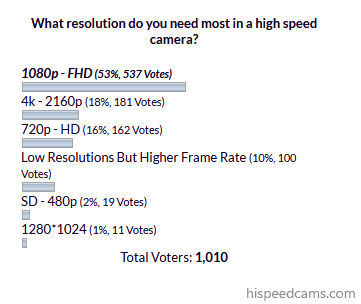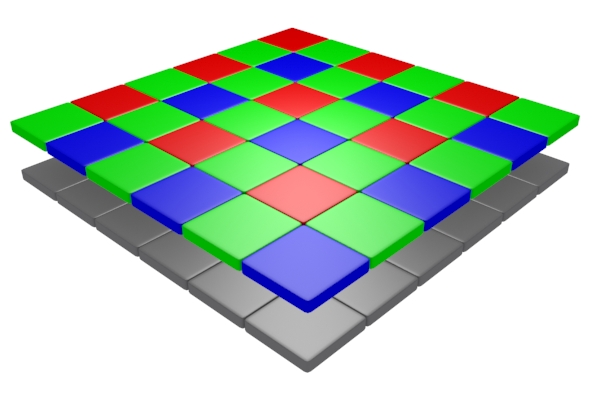Resolution is one of the most important aspects of any camera image. In slow motion it could be the difference in showing important details or just obscure an event all-together. In machinery failures during manufacturing; low resolution and high resolution can mean the difference in spotting a crack or bend in the process and that is hugely important.
For film makers and videographers resolution weights a lot when deciding upon a slow motion camera solution. Not to long ago slow motion cameras at or under 1 megapixel 1024*1024 for example was a novelty and a luxury. Nowadays 1280*720px or the lower end of HD resolution is easy to find and widely used. However 1080p and or 4k are the resolutions that seem to cause the most interest.
Resolution Poll Results:

1080p is the winner!
Looking at the results of 1000+ participants we can clearly see a preference for 1080p or 1920*1080px as the most wanted resolution for high speed imaging. Full HD is now ubiquitous in the world of TVs and 720p is relegated to TV signals from a few broadcasters. 1080p can be recorded by almost any device from a pocket cellphone or action camera to a high end broadcast camera. It is the resolution of comfort for delivery of content and the pixel resolution suits most eyes comfortably in TVs and monitors at regular distances. It is only when getting closer to the display that pixels become easily apparent. Furthermore, 4k TV sets make an excellent job of up-scaling 1080p content to 4k by doubling the resolution which looks phenomenal even at close inspection.
1080p at 1000fps should be the next affordable slow motion camera target and we may see it very soon from several sources as technology and the market for them grows. Affordable as in 5k USD or less is our estimation.
Second runner up 4k!
For camera manufacturers in the high speed realm, 1080p should be the native resolution of the cameras with 4k being the option for film makers and videographers looking for limited high speed frame rates of 1000fps and under. For anything over that the cost today in memory and sensor technology is prohibitively high. The Phantom Flex 4k is a five figure camera system and maxes out at 4k 1000fps. Other cameras do offer up to 240fps 4k at more affordable pricing but still mostly out of the budget video enthusiast radar. The fps1000 4k could be the alternative but we are still waiting for it to materialize.
4k Slow motion will be needed for the future ever more with VR and higher resolution displays. The amount of detail 4k can capture in slow motion is astounding and can help scientists and film makers realize shots not possible before.
The low light capabilities will be lower due to pixel density and high frame rates capped at the native resolution of 4k but windowing could still happen at much higher frame rates if sensor tech allows.
First Phantom 4k Footage by Gregory Wilson:
What about 720p?
HD 720p resolution did get a solid 3rd place in the poll and will continue to be an important resolution along with 1280*1024 which is the regular sensor size in these configurations. These cameras should continue to have excellent low light capabilities and extremely high frame rates at the cost of overall resolution. The edgertronic camera is the current king of this resolution for budget consumers with a shipping unit.
The proposed Hex fps1000 camera will do 720p at up to 4000fps if the performance is there. This could be a great option for scientists and educators. Monochrome versions of all these cameras will edge out their color counterparts in low light and detail abilities due to the absence of a Bayer pattern filter sensor : See here.
SD resolution and lower:
There is no question that SD or standard def and lower resolutions are out for the winning attention of buyers but there is still some interest. There are scientists and industrial users that need extremely high frame rates at any cost to detect very short duration events. You need frame rates in the hundreds of thousands of frames/ second to capture these. Cameras will continue to be built to handle these but only for very specialized uses. Slow motion mainstream will still be a relatively low frame rate affair. 5k fps and below is probably the sweet-spot for most slow motion uses in TV, Film, education and science labs.
SD resolution and lower will still be available by windowed sensor modes in many higher resolution cameras. Windowing can increase frame rate by using less of the sensor or by skipping lines to generate higher speed captures.
Conclusion:
The people have spoken, the market yearns for affordable 1080p slow motion cameras that can do 1000fps or more. Manufacturers should take note and start delivering the next wave of high speed camera hardware on affordable pricing. If they haven’t done so or are close to shipping already.
New Poll at HSC:
We have a new poll What is your Main Use for a Slow Motion Camera? This will be interesting to see if the use of these cameras is more geared towards leisure, science or content creation.
Thank you for your participation!
If you are looking for a slow motion camera and don’t know where to start; visit our HSC Camera Guide which ranks them for you!

